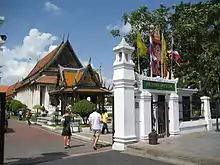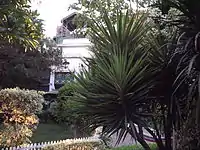Major Stanley Smyth Flower OBE | |
|---|---|
| Born | 1 August 1871 Lincoln's Inn Fields, London, England |
| Died | 3 February 1946 Tring, Hertfordshire, England |
| Allegiance | |
| Service/ | |
| Rank | Major |
| Unit | Royal Northumberland Fusiliers |
| Commands held | Egyptian Camel Transport Corps |
| Battles/wars | World War I Sinai and Palestine Campaign |
| Awards | OBE |
| Other work | Zoologist |
Major Stanley Smyth Flower OBE FLS FZS (1 August 1871 – 3 February 1946) was an English army officer, science advisor, administrator, zoologist and conservationist.[1][2]
.jpg.webp)
Early years
Second son of Sir William Henry Flower FRS and his wife Georgiana Rosetta, daughter of Admiral William Henry Smyth FRS, he was born on 1 August 1871 in the Hunterian Museum at the Royal College of Surgeons of which his father was then Curator,

and was baptised in St Cross Church, Oxford on 3 September 1871.[3] Among his first cousins were Sir Archibald Dennis Flower, head of the family brewery, the soldier Nevill Smyth VC, and Robert Baden-Powell, founder of the Boy Scout movement. Taking an early interest in natural history, from the age of eleven he regularly went to meetings of the Zoological Society of London with his father. After attending Wellington College, Berkshire, he studied at King's College London and joined the Artists' Rifles.

In 1890 he joined the Northumberland Fusiliers, where he received a regular commission as second lieutenant on 23 April 1893, and was promoted to lieutenant on 19 December 1893.[4] With his regiment he went to India and the Straits Settlements, where he studied the fauna.
Scientific career
In 1896 the government of Siam was looking for a scientific advisor to manage the collections in the Royal Museum and he was awarded the post.

Given leave by the British Army, he married his fiancée and the two set off for Bangkok. While there, they were able to make several trips in Siam and the Malay Peninsula to study the vertebrate fauna. A snake he collected there was described as a species new to science and named Typhlops floweri after him by George Albert Boulenger in 1899.[5][6] In 2010 the species was moved to the genus Gerrhopilus as Gerrhopilus floweri.[7] In 1912 Boulenger named a species of lizard Calotes floweri after Flower, the scientific name of which was changed to Pseudocalotes floweri in 1980.[6][8] In 1898 the government of Egypt under Lord Cromer wanted to appoint a Director of the Zoological Gardens at Giza and he gained the post, which he held until his retirement.

While still on leave from his regiment, he was promoted captain on 17 February 1900.[9][10]
In 1913 Field-Marshal Lord Kitchener sent him to India to report on the collections of wild animals held in captivity there. In a letter from Egypt that year, Rudyard Kipling wrote that Flower was "one of the most interesting men I have ever met".[11]
While in Egypt, he organised the Zoological Museum in a building in Giza Zoo, started the Fish Garden with aquarium on Gezira Island, and was appointed Ranger of Central Africa.

As well as establishing and enforcing game laws in Egypt and Sudan, he was active both in identification of unknown species and conservation of known species at risk. To him is ascribed the preservation of the egret, threatened with extinction for its plumes, that was protected by law in Egypt from 1912.[12]
First World War and aftermath
Recalled to the British Army on 5 November 1914,[13] his knowledge of Egypt and its animals was used to set up and run the Egyptian Camel Transport Corps, a logistical unit which carried much of the supplies needed by the British Empire forces fighting the Ottoman Empire in the Sinai and Palestine Campaign.
Once the Turks were beaten at the end of 1918, the Egyptians rose against British rule in the Egyptian Revolution of 1919. Acting as Inspector of the Interior and as Political Officer, he maintained order in Giza and for his role in this conflict was appointed an OBE.[14]
Later years
In April 1924, his health impaired, he resigned his post and with his wife returned to England to settle near Tring, where he could pursue his studies at the Walter Rothschild Zoological Museum. During his retirement, he visited many zoos around the world and wrote many papers on mammals, birds, reptiles, fishes and amphibians of Egypt as well as on animal longevity. He was vice-president of the Zoological Society of London from 1927 to 1929 and chair of the British Ornithologists' Club from 1930 to 1933.[15] He died at Tring on 3 February 1946 and was buried in the town cemetery, with his will being proved at Oxford on 6 June 1946.[16]
Family
On 30 September 1896 at Worplesdon in Surrey he married Sibylla Maria Peckham Wallace, known as Sybil (1876–1938), the elder daughter of Charles William Napier Wallace (1849–1910), a grandson of General Peter Margetson Wallace, and his first wife Frances Henrietta Peckham (1847–1893), a granddaughter of Bishop Robert James Carr.[17] They had four children. After the death of his first wife, on 4 May 1939 at Marylebone in London he married Charlotte Dorothea Rose Stewart (1889–1981),[18] who survived him.
Selected publications
- Report on a zoological mission to India, 1913. Cairo: Government Press. 1914.
- The principal species of birds protected by law in Egypt, giving their English, French, Arabic, and scientific names, their local status, their approximate size, and concise notes on their coloration, for purposes of identification. 1918.
- List of fishes, 1901–1921. Cairo: Government Press. 1921.
- List of the vertebrated animals exhibited in the gardens of the Zoological Society of London, 1828–1927 (10th ed.). London: The Zoological Society. 1929.
References
- ↑ Moore, Amberley; Warr, Frances (October 2009). "Stanley Smyth Flower: professional soldier, science advisor, administrator, zoologist". Archives of Natural History. 36 (2): 361–362. doi:10.3366/E0260954109001107.
- ↑ "Obituary: Major S. S. Flower, O.B.E." Nature. 157 (3985): 327–328. 16 March 1946. doi:10.1038/157327a0.
- ↑ Oxfordshire Family History Society, Oxford, Oxfordshire, England; Anglican Parish Registers; Reference Number: PAR199/1/R2/2
- ↑ Hart′s Army list, 1901
- ↑ Flower, Stanley Smyth (1899). "Notes on a Second Collection of Reptiles made in the Malay Peninsula and Siam, from November 1896 to September 1898, with a List of the Species recorded from those Countries". Proceedings of the Zoological Society of London: 600–696.
- 1 2 Beolens, Bo; Watkins, Michael; Grayson, Michael (2011). The Eponym Dictionary of Reptiles. Baltimore: Johns Hopkins University Press. xiii + 296 pp. ISBN 978-1-4214-0135-5. ("Flower", p. 91).
- ↑ Species Gerrhopilus floweri at The Reptile Database www.reptile-database.org.
- ↑ Species Pseudocalotes floweri at The Reptile Database www.reptile-database.org.
- ↑ "No. 27174". The London Gazette. 16 March 1900. p. 1793.
- ↑ "No. 27177". The London Gazette. 27 March 1900. p. 2041.
- ↑ Thomas Pinney, ed. (1999), "To his son John Kipling from Egypt, 17 February 1913", The Letters of Rudyard Kipling, vol. 4, University of Iowa Press.
- ↑ "Law No. 9 of May 20,1912, "The Protection of Birds useful to Agriculture"". The Journal of the South African Ornithologists' Union. Pretoria. X. 1915.
- ↑ Army Medal Office. WWI Medal Index Cards. In the care of The Western Front Association website.
- ↑ "No. 32028". The London Gazette. 24 August 1920. p. 8709.
- ↑ Chaworth-Musters, J. L. (1946). "Obituary. Major S. S. Flower, O.B.E." Ibis. 88: 242–245. doi:10.1111/j.1474-919x.1946.tb03481.x.
- ↑ "England and Wales, National Index of Wills and Administrations, 1858-1957". Retrieved 25 February 2023.
- ↑ England Marriages, 1538–1973, retrieved 20 January 2017 Stanley Smyth Flower and Sibylla Maria Peckham Wallace, 30 September 1896, Worplesdon, Surrey, England; reference item 18 p 18; FHL microfilm 994,435
- ↑ "England and Wales Marriage Registration Index, 1837-2005". Retrieved 25 February 2023.